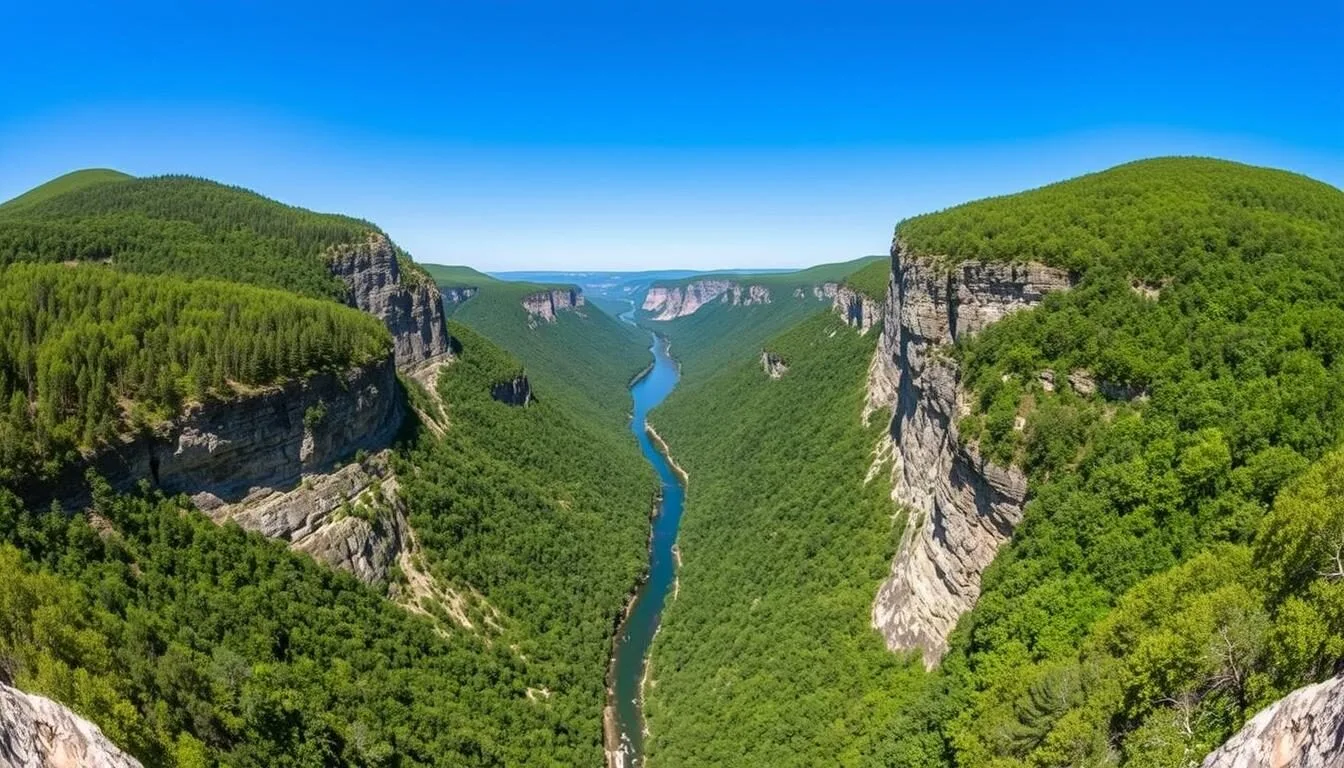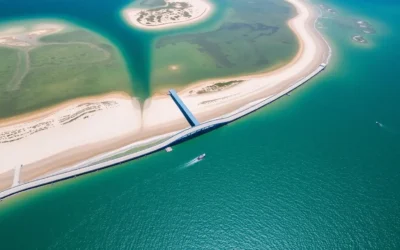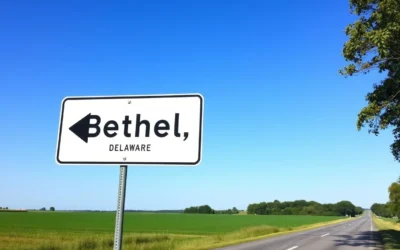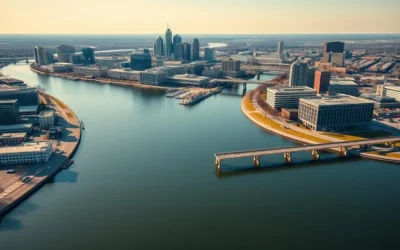Did you know the Delaware Water Gap National Recreation Area spans an impressive 70,000 acres across Pennsylvania and New Jersey? This natural wonder, where the Delaware River cuts dramatically through the Appalachian Mountains, attracts over 3 million visitors annually seeking outdoor adventures and scenic beauty. As one of the most accessible wilderness areas from major East Coast cities, this geological masterpiece offers far more than just its famous gap.
Getting to Delaware Water Gap, Pennsylvania
Located at the eastern edge of Pennsylvania, Delaware Water Gap is easily accessible from several major cities. From New York City, it’s a scenic 90-minute drive west via Interstate 80, which runs directly through the gap itself. Philadelphia visitors can reach the area in about 2 hours by taking I-476 north to I-80 east. For those coming from further away, the nearest major airports are Newark Liberty International and Lehigh Valley International.
Ready to Visit Delaware Water Gap?
Find the best flight deals to start your Pennsylvania adventure!
Planning Your Journey to Delaware Water Gap
The Delaware Water Gap National Recreation Area offers activities year-round, but your experience will vary dramatically with the seasons. Summer brings warm temperatures perfect for water activities and hiking, while fall transforms the landscape with spectacular foliage. Winter offers a quieter experience with opportunities for cross-country skiing and snowshoeing, and spring showcases rushing waterfalls and blooming wildflowers.

When to Visit Delaware Water Gap
The ideal time to visit depends on your preferred activities. For hiking and water recreation, late May through September offers the best conditions with temperatures averaging 70-85°F (21-29°C). Fall foliage peaks in mid-October, creating a photographer’s paradise. Winter visitors should prepare for temperatures that can drop below freezing, while spring (April-May) brings moderate temperatures and fewer crowds.
Summer (June-August)
- Peak season with warmest temperatures
- Ideal for swimming, kayaking, and camping
- All trails and facilities fully operational
- Higher visitor numbers, especially on weekends
Fall (September-November)
- Spectacular foliage, especially mid-October
- Comfortable hiking temperatures
- Less crowded than summer
- Perfect for photography and scenic drives
Winter (December-February)
- Snow-covered landscapes
- Cross-country skiing and snowshoeing
- Fewest visitors, peaceful atmosphere
- Some facilities closed or limited hours
Spring (March-May)
- Waterfalls at peak flow
- Wildflowers begin blooming
- Gradually warming temperatures
- Fewer crowds than summer months
Getting Around Delaware Water Gap
Having your own vehicle is essential for exploring the Delaware Water Gap National Recreation Area, as public transportation within the park is limited. The area spans 40 miles along the Delaware River, with numerous trailheads, viewpoints, and attractions spread throughout. Interstate 80 provides the main access point, while Route 209 runs north-south through the Pennsylvania side of the park.

Explore at Your Own Pace
Rent a car to discover all the hidden gems of Delaware Water Gap!
Navigating the Park
The Delaware Water Gap National Recreation Area is divided by the Delaware River, with attractions on both the Pennsylvania and New Jersey sides. Most visitors focus on the Pennsylvania portion, which offers easier access to popular trails and viewpoints. The park’s visitor centers in Bushkill, PA and Dingmans Ferry, PA provide maps, trail information, and ranger assistance.
Practical Tip: Download offline maps before your visit, as cell service can be spotty throughout the park, especially in ravines and remote areas.
Where to Stay in Delaware Water Gap, Pennsylvania
The Delaware Water Gap area offers a range of accommodation options, from historic inns to modern hotels and rustic campgrounds. The borough of Delaware Water Gap itself has several charming places to stay, while nearby Stroudsburg provides additional options just a short drive away.

Historic Inns
Experience the area’s rich history at the Deer Head Inn, home to America’s oldest continuously running jazz club, or the beautifully restored Shawnee Inn and Golf Resort dating back to 1911.
Campgrounds
Connect with nature at the Delaware Water Gap/Pocono Mountain KOA or Driftstone Campground, both offering scenic riverside sites perfect for tents and RVs with modern amenities.
Modern Hotels
For contemporary comforts, the Pocono Inn & Banquet offers convenient accommodations, while Club Wyndham Shawnee Village provides spacious vacation rental villas ideal for families.
Find Your Perfect Stay
Book accommodations in and around Delaware Water Gap for your next adventure!
Hiker’s Tip: Appalachian Trail through-hikers can find welcome respite at the Church of the Mountain Hostel in Delaware Water Gap borough, which offers affordable lodging, hot showers, and a weekly potluck dinner.
Top Hiking Trails in Delaware Water Gap
Hiking is the premier activity in Delaware Water Gap, with trails ranging from easy riverside walks to challenging mountain ascents. The area’s 100+ miles of trails offer something for every skill level, with the most popular routes leading to panoramic vistas of the gap itself.

Mount Tammany (Red Dot Trail)
The most popular and challenging hike in the park takes you to the summit of Mount Tammany on the New Jersey side. This strenuous 3.5-mile loop climbs 1,250 feet to reward hikers with spectacular views of the gap, the Delaware River, and Mount Minsi on the Pennsylvania side. The trail is marked with red dots and takes approximately 2-4 hours to complete depending on your pace and how long you linger at the viewpoints.
Mount Minsi (Appalachian Trail)
On the Pennsylvania side, the hike to Mount Minsi follows a section of the famous Appalachian Trail. This moderate 5-mile round trip offers several scenic overlooks of the gap and culminates at the summit with views of Mount Tammany across the river. The white-blazed trail is well-maintained and takes about 3-4 hours to complete.

Dunnfield Creek Trail
This moderate 3.5-mile trail follows a picturesque creek through a hemlock ravine to the serene Sunfish Pond, a glacial lake perched on the mountain. The trail features numerous stream crossings and connects with the Appalachian Trail, offering options to extend your hike. The green-blazed path takes about 3 hours round trip.
Safety Tip: Always carry plenty of water, wear appropriate footwear, and check weather conditions before hiking. The rocky terrain can be slippery when wet, and summer temperatures can be surprisingly hot on exposed ridgelines.
Spectacular Waterfalls to Visit
The Delaware Water Gap region is home to some of Pennsylvania’s most impressive waterfalls, with the northern section of the park featuring several easily accessible cascades. These natural wonders are especially dramatic in spring when snowmelt and rainfall increase water flow.

Raymondskill Falls
Pennsylvania’s tallest waterfall, Raymondskill Falls drops 150 feet in three distinct tiers. A short but steep 0.3-mile trail leads from the parking area to viewing platforms at the top and middle sections of the falls. Located near Milford, this impressive cascade is just a few feet shorter than Niagara Falls when all three tiers are combined.
Dingmans Falls
The second-highest waterfall in Pennsylvania, Dingmans Falls plunges 130 feet down a terraced cliff. A flat, accessible boardwalk trail leads 0.4 miles through a hemlock ravine past the smaller Silver Thread Falls to reach the main cascade. A staircase allows visitors to climb to an upper viewing platform for a different perspective.
Bushkill Falls
Though technically outside the national recreation area, Bushkill Falls is a popular private attraction featuring eight waterfalls connected by a network of trails and bridges. Known as the “Niagara of Pennsylvania,” the main falls drops 100 feet into a rocky gorge. Admission is charged, but the well-maintained trails and facilities make it family-friendly.
River Adventures in Delaware Water Gap
The Delaware River is the lifeblood of the park, offering 40 miles of clean water perfect for swimming, fishing, and paddling. Floating through the actual gap, with towering cliffs on either side, provides a unique perspective on this natural wonder that can’t be experienced from land.

Kayaking and Canoeing
Paddling the Delaware River offers a peaceful way to experience the park’s beauty. Several local outfitters provide rentals and shuttle services, including Edge of the Woods Outfitters in Delaware Water Gap borough and Shawnee River Trips in Shawnee-on-Delaware. The river features mostly gentle Class I rapids suitable for beginners, with a few Class II sections during higher water.
Tubing
On hot summer days, tubing provides a relaxing way to cool off while drifting down the river. Outfitters like Delaware River Tubing offer inflatable tubes and transportation, allowing you to simply float and enjoy the scenery. The most popular tubing section runs from Smithfield Beach to the Delaware Water Gap.
Fishing
The Delaware River is renowned for its excellent fishing, particularly for smallmouth bass, walleye, and American shad (during the spring run). The river’s clean, cool waters also support trout in tributary streams. Fishing licenses from either Pennsylvania or New Jersey are honored on the main river, but state-specific licenses are required on tributaries.
Water Safety: Always wear a life jacket when on the river, even when swimming. The Delaware’s current can be deceptively strong, and underwater obstacles can create dangerous conditions even for experienced swimmers.
Historic Sites in Delaware Water Gap
Beyond its natural beauty, the Delaware Water Gap area is rich in history, from Native American settlements to early colonial farms and the grand resort era of the late 19th century. Several preserved historic sites offer glimpses into the region’s past.

Millbrook Village
This recreated 19th-century village offers a glimpse of rural life in the 1800s. Though most of the original buildings are gone, several have been restored or reconstructed to demonstrate traditional crafts and daily life. On summer weekends, volunteers in period clothing demonstrate blacksmithing, spinning, and other historic skills.
Minisink Archaeological Site
This significant archaeological site preserves evidence of both Native American settlements and early European colonization. Interpretive signs explain the history of the Minisink region, which was an important Native American gathering place before becoming one of the earliest European settlements in the upper Delaware Valley.
The Castle Inn
Located in the borough of Delaware Water Gap, this impressive stone building was once one of the grand hotels that made the area a popular resort destination in the late 19th and early 20th centuries. Though no longer operating as a hotel, parts of the building are open for tours that highlight the region’s heyday as a vacation spot for wealthy urbanites.
Practical Tips for Visiting Delaware Water Gap

Park Information
The Delaware Water Gap National Recreation Area is open 24 hours a day, year-round. There is no entrance fee, though some beaches and boat launches charge amenity fees during the summer season. Visitor centers in Bushkill and Dingmans Ferry provide maps, exhibits, and ranger assistance.
Cell Service and Connectivity
Cell phone coverage is spotty throughout the park, especially in ravines and remote areas. Download maps and information before your visit, and don’t rely solely on your phone for navigation or emergency communication.
Wildlife Safety
The park is home to black bears, timber rattlesnakes, and copperheads. While encounters are rare, it’s important to store food properly when camping, make noise while hiking, and watch where you step or place your hands on rocky areas.
| Essential Items | Description |
| Water | Bring at least 1 liter per person per hour of hiking, especially in summer |
| Map | Physical map or downloaded offline maps (don’t rely on cell service) |
| Proper Footwear | Sturdy hiking boots or shoes with good traction for rocky trails |
| Sun Protection | Sunscreen, hat, and sunglasses, even on cloudy days |
| First Aid Kit | Basic supplies for minor injuries, including blister treatment |
| Life Jacket | Required by law when on the river in any watercraft |
Experience the Wonder of Delaware Water Gap
From challenging hikes with breathtaking views to peaceful paddles along the Delaware River, the Delaware Water Gap offers a perfect blend of adventure and tranquility just a short drive from major East Coast cities. Whether you’re seeking a weekend escape or a week-long exploration, this natural wonder provides endless opportunities to connect with nature and history.

As you plan your visit to this geological masterpiece where the Delaware River carved its way through the ancient Appalachian Mountains, remember that each season offers its own unique charm. Whether you’re watching eagles soar above the river in winter, hiking to waterfalls in spring, swimming in refreshing pools in summer, or photographing the spectacular fall foliage, Delaware Water Gap rewards visitors with unforgettable natural beauty in every season.
Ready for Your Delaware Water Gap Adventure?
Start planning your perfect getaway today!
The above is subject to change.
Check back often to TRAVEL.COM for the latest travel tips and deals.






